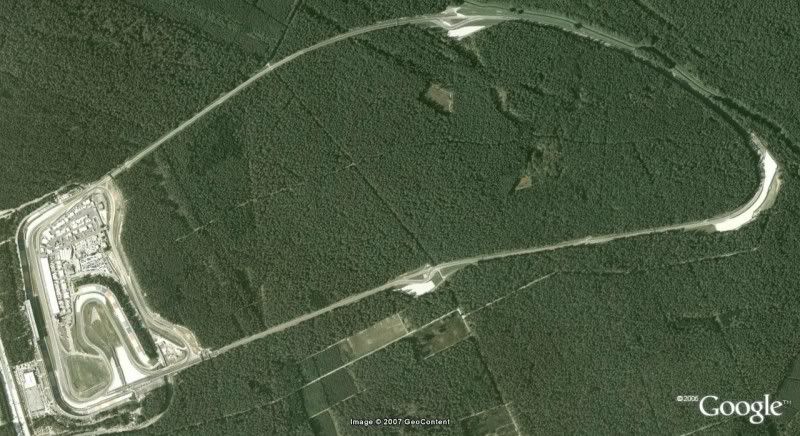 |
| The original Hockenheimring , now half gone but not forgotten (Google Maps) |
The Grosser Preis Von Deutschland at the venerable Hockenheimring marks the half way point of the season. The historic circuit is now about half as long as it once was, and about half as dramatic, albeit much less dangerous...
A sense of dramatic foreboding pervaded the original track, a
tangibly eerie aura in a theatre of speed resembling two parallel
stretches of no-speed-limit German autobahn connected at each
end by quick corners. Most of the nearly 7km-long lap took place
in a dense, dark and mysterious pine forest. Danger lurked in the
Hockenheimring's hidden depths, where speed gone wrong could
be deadly.
Over the years safety concerns prompted changes that included
chicanes to slow the cars down on the tree-lined straights, where
speeds of well over 350kph were the norm. One chicane, the Jim
Clark-Kurve, was constructed near where the great Scot was killed
in 1968 when his Lotus F2 car flew into the forest.
https://www.youtube.com/watch?v=fyMD9HodD9w
In 1980 Patrick Depailler died at the Ostkurve, the halfway point
in the forest, when his Alfa Romeo was destroyed in a massive
accident. In 1982 Didier Pironi suffered a career-ending crash
during heavy rain when his Ferrari flew into a ball of spray that
contained the slow moving Renault of Alain Prost. Ayrton Senna
respected the test of nerve that was the Hockenheimring (he won the
race three times, from 1988 to 1990), though he also experienced
the dangerous circuit's darker side. In 1991 he was travelling at an
estimated 330kph when his McLaren launched itself of a kerb and
somersaulted off the track just 50 meters away from a memorial stone
dedicated to the late Jim Clark. Senna said the frightening incident
reminded him that "we're not immortal. I will think about it again
but I will not slow down. If I did I would not be a racing driver."
In 2002 the track was reconfigured and sanitised (by Herman
Tilke) to eliminate most of the fearsome forest section. The new
route veered right before the Clark-Kurve and by means of a long
curving straight connected with the old circuit near the Ayrton
Senna-Kurve, where a second spectator stadium was constructed in
emulation of the Hockenheimring's uniquely unchanged landmark.
The spectacular Stadium section, an enormous concrete grandstand
towering above the start/finish straight, accomodates well over
100,000 motorsport-mad fans who herald the passage of the F1 cars
- especially those driven by local heroes - with a flurry of
furiously waved German flags and banners, a cacaphonous
hullaballoo of bellowing air horns and deafening explosions of
giant firecrackers. Though the demented antics and almighty din
of the Hockenheimring's automaniacs adds much to the supercharged
spectacle, some find the sturm und drang of the Wagnerian-opera-
gone-mad atmosphere rather menacing.
"I love it. It gives me goosebumps," Michael Schumacher used to say.
"And even with earplugs, a crash helmet and the engine screaming
I can still hear the noise of the crowd."
Here's Schumi (4-times a winner of his home race) on a lap of the old Hockenheimring...
http://www.youtube.com/watch?v=XrBMNU8t7Mc

This comment has been removed by a blog administrator.
ReplyDelete